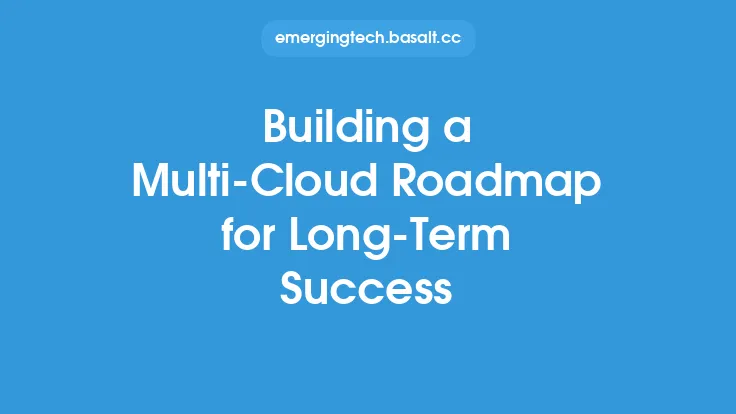Implementing a multi-cloud architecture is a complex task that requires careful planning, execution, and management. A well-designed multi-cloud architecture can provide numerous benefits, including increased flexibility, scalability, and reliability, as well as improved security and reduced costs. However, a poorly designed architecture can lead to increased complexity, higher costs, and reduced performance. In this article, we will discuss the best practices for implementing a multi-cloud architecture, including the key considerations, design principles, and technical requirements.
Introduction to Multi-Cloud Architecture
A multi-cloud architecture is a type of cloud computing architecture that involves the use of multiple cloud services, including public, private, and hybrid clouds. This approach allows organizations to take advantage of the strengths of each cloud service, while minimizing their weaknesses. A multi-cloud architecture typically consists of a combination of cloud services, including infrastructure as a service (IaaS), platform as a service (PaaS), and software as a service (SaaS). The key benefits of a multi-cloud architecture include increased flexibility, scalability, and reliability, as well as improved security and reduced costs.
Key Considerations for Multi-Cloud Architecture
When implementing a multi-cloud architecture, there are several key considerations that must be taken into account. These include:
- Cloud Service Selection: The selection of cloud services is critical to the success of a multi-cloud architecture. Organizations must carefully evaluate the strengths and weaknesses of each cloud service, including their scalability, security, and reliability.
- Integration and Interoperability: Integration and interoperability are critical components of a multi-cloud architecture. Organizations must ensure that their cloud services can communicate with each other seamlessly, and that data can be easily transferred between services.
- Security and Compliance: Security and compliance are critical considerations for any cloud architecture. Organizations must ensure that their cloud services meet all relevant security and compliance requirements, including data encryption, access controls, and auditing.
- Cost Management: Cost management is a critical component of a multi-cloud architecture. Organizations must carefully monitor and manage their cloud costs, including the costs of data transfer, storage, and compute resources.
Design Principles for Multi-Cloud Architecture
When designing a multi-cloud architecture, there are several key design principles that must be taken into account. These include:
- Modularity: A modular design approach is critical to the success of a multi-cloud architecture. This involves breaking down the architecture into smaller, independent components, each of which can be easily scaled, upgraded, or replaced.
- Scalability: Scalability is a critical component of a multi-cloud architecture. Organizations must ensure that their cloud services can scale easily to meet changing business requirements.
- Flexibility: Flexibility is also critical to the success of a multi-cloud architecture. Organizations must ensure that their cloud services can be easily adapted to meet changing business requirements.
- Reliability: Reliability is a critical component of a multi-cloud architecture. Organizations must ensure that their cloud services are highly available and can recover quickly from failures.
Technical Requirements for Multi-Cloud Architecture
When implementing a multi-cloud architecture, there are several technical requirements that must be taken into account. These include:
- Cloud Management Platforms: A cloud management platform is critical to the success of a multi-cloud architecture. This involves the use of a platform that can manage and monitor multiple cloud services, including public, private, and hybrid clouds.
- APIs and Integration: APIs and integration are critical components of a multi-cloud architecture. Organizations must ensure that their cloud services can communicate with each other seamlessly, using APIs and other integration technologies.
- Security and Compliance Tools: Security and compliance tools are critical to the success of a multi-cloud architecture. Organizations must ensure that their cloud services meet all relevant security and compliance requirements, using tools such as data encryption, access controls, and auditing.
- Monitoring and Analytics: Monitoring and analytics are critical components of a multi-cloud architecture. Organizations must ensure that they have visibility into the performance and security of their cloud services, using monitoring and analytics tools.
Best Practices for Implementing Multi-Cloud Architecture
When implementing a multi-cloud architecture, there are several best practices that must be taken into account. These include:
- Develop a Clear Cloud Strategy: A clear cloud strategy is critical to the success of a multi-cloud architecture. Organizations must carefully evaluate their business requirements and develop a cloud strategy that meets those requirements.
- Assess Cloud Service Providers: Assessing cloud service providers is critical to the success of a multi-cloud architecture. Organizations must carefully evaluate the strengths and weaknesses of each cloud service provider, including their scalability, security, and reliability.
- Implement a Cloud Management Platform: Implementing a cloud management platform is critical to the success of a multi-cloud architecture. This involves the use of a platform that can manage and monitor multiple cloud services, including public, private, and hybrid clouds.
- Monitor and Optimize Cloud Services: Monitoring and optimizing cloud services is critical to the success of a multi-cloud architecture. Organizations must ensure that they have visibility into the performance and security of their cloud services, and that they can optimize those services to meet changing business requirements.
Conclusion
Implementing a multi-cloud architecture is a complex task that requires careful planning, execution, and management. By following the best practices outlined in this article, organizations can ensure that their multi-cloud architecture is designed and implemented to meet their business requirements, while minimizing complexity and costs. A well-designed multi-cloud architecture can provide numerous benefits, including increased flexibility, scalability, and reliability, as well as improved security and reduced costs. As the cloud computing landscape continues to evolve, it is likely that multi-cloud architectures will become increasingly popular, as organizations seek to take advantage of the strengths of each cloud service, while minimizing their weaknesses.





